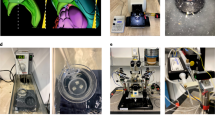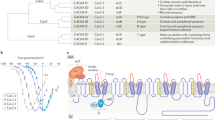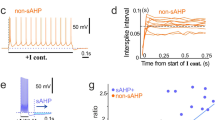Abstract
There is considerable evidence that glutamate is the principal neurotransmitter that mediates fast excitatory synaptic transmission in the vertebrate central nervous system1–3. This single transmitter seems to activate two or three distinct types of receptors, defined by their affinities for three selective structural analogues of glutamate, NMDA (N-methyl-D-aspartate), quisqualate and kainate1–6. All these agonists increase membrane permeability to monovalent cations7–9, but NMDA also activates a conductance that permits significant calcium influx10,11 and is blocked in a voltage-dependent manner by extracellular magnesium12,13. Fast synaptic excitation seems to be mediated mainly by kainate/quisqualate receptors14–18, although NMDA receptors are sometimes activated 19–21. We have investigated the properties of these conductances using single-channel recording22 in primary cultures of hippocampal neurons, because the hippocampus contains all subtypes of glutamate receptors23,24 and because long-term potentiation of synaptic transmission occurs in this structure25,26. We find that four or more distinct single-channel currents are evoked by applying glutamate to each outside-out membrane patch. These conductances vary in their ionic permeability and in the agonist most effective in causing them to open. Clear transitions between all the conductance levels are observed. Our observations are compatible with the model that all the single channel conductances activated by glutamate reflect the operation of one or two complex molecular entities.
This is a preview of subscription content, access via your institution
Access options
Subscribe to this journal
Receive 51 print issues and online access
$199.00 per year
only $3.90 per issue
Buy this article
- Purchase on Springer Link
- Instant access to full article PDF
Prices may be subject to local taxes which are calculated during checkout
Similar content being viewed by others
References
Watkins, J. C. & Evans, R. H. A. Rev. Pharmac. Tox. 21, 165–204 (1981).
McLennan, H. in Glutamate as a Neurotransmitter (eds Di Chiara, G. & Gessa, G. L.) 253–262 (Raven, New York, 1981).
Foster, A. C. & Fagg, G. E. Brain Res. Rev. 7, 103–164 (1984).
O'Brien, R. J. & Fischbach, G. D. J. Neurosci. 6, 327–3283 (1986).
Ishida, A. T. & Neyton, J. Proc. natn. Acad. Sci. U.S.A. 82, 1837–1841 (1985).
Kiskin, N. I., Krishtal, O. A. & Tsyndrenko, A. Ya. Neurosci. Lett. 63, 225–230 (1986).
MacDonald, J. F. & Wojtowicz, J. M. Can. J. Physiol. Pharmac. 58, 1393–1397 (1980).
Crunelli, V., Forda, S. & Kelly, J. S. J. Physiol., Lond. 351, 327–342 (1984).
Hablitz, J. J. & Langmoen, I. A. J. Physiol. Lond. 325, 317–331 (1982).
Ascher, P. & Nowak, L. J. Physiol., Lond. 377, 43P (1986).
MacDermott, A. B., Mayer, M. L., Westbrook, G. L., Smith, S. J. & Barker, J. L. Nature 321, 519–522 (1986).
Nowak, L., Bregestovski, P., Ascher, P., Herbet, A. & Prochiantz, A. Nature 307, 462–465 (1984).
Mayer, M. L., Westbrook, G. L. & Guthrie, P. B. Nature 309, 261–263 (1984).
Collingridge, G. L., Kehl, S. J. & McLennan, H. J. Physiol., Lond. 334, 19–31 (1983).
Crunelli, V., Forda, S. & Kelly, J. S. J. Physiol., Lond. 341, 627–640 (1983).
Jahr, C. E. and Jessell, T. M. J. Neurosci. 5, 2281–2289 (1985).
Jahr, C. E. and Yoshioka, K. J. Physiol., Lond. 370, 515–530 (1986).
Nelson, P. G., Pun, R. Y. K. & Westbrook, G. L. J. Physiol., Lond. 372, 169–190 (1986).
Thomson, A. M. J. Physiol., Lond. 370, 531–549 (1986).
Coan, E. J. & Collingridge, G. L. Neurosci. Lett. 53, 21–26 (1985).
Dale, N. & Roberts, A. J. Physiol., Lond. 363, 35–59 (1985).
Hamill, O. P., Marty, A., Neher, E., Sakmann, B. & Sigworth, F. J. Pflügers Arch. ges Physiol. 391, 85–100 (1981).
Hablitz, J. J. Brain Res. 247, 149–153 (1982).
Crunelli, V., Forda, S. & Kelly, J. S. J. Physiol., Lond. 351, 327–342 (1984).
Bliss, T. V. P. & Lomo, T. J. J. Physiol., Lond. 232, 331–356 (1973).
Bliss, T. V. P. & Gardner-Medwin, A. R. J. Physiol. Lond. 232, 357–374 (1973).
Labarca, P. & Miller, C. J. Membrane Biol. 61, 31–38 (1981).
Krouse, M. E., Schneider, G. T. & Gage, P. W. Nature 319, 58–60 (1986).
Cull-Candy, S. G. & Ogden, D. C. Proc. R. Soc. B224, 367–373 (1985).
Ascher, P. & Nowak, L. Proc. int. Un. physiol. Sci. 16, 382 (1986).
Greenamyre, J. T., Olson, J. M. M., Penney, J. B. & Young, A. B. J. Pharmac Exp. Ther. 233, 254–263 (1985).
Monaghan, D. T., Holets, V. R., Toy, D. W. & Cotman, C. W. Nature 306, 176–179 (1983).
Wigstrom, H., Gustaffson, B., Huang, Y. Y. & Abraham, W. C. Acta physiol. scand. 126, 317–319 (1986).
Malinow, R. & Miller, J. P. Nature 320, 529–530 (1986).
Kelso, S. R., Ganong, A. H. & Brown, T. H. Proc. natn. Acad. Sci. U.S.A. 83, 5326–5330 (1986).
Kennedy, M. B., Bennett, M. K. & Erondu, N. E. Proc. natn. Acad. Sci. U.S.A. 80, 7357–7361 (1983).
Ouimet, C. C., McGuinnes, T. L. & Greengard, P. Proc. natn. Acad. Sci. U.S.A. 81, 5604–5608 (1984).
Miller, S. G. & Kennedy, M. B. Cell 44, 861–870 (1986).
Saitoh, T. & Schwartz, J. H. J. Cell Biol. 100, 835–842 (1985).
Lai, Y., Nairn, A. C. & Greengard, P. Proc. natn. Acad. Sci. U.S.A. 83, 4253–4257 (1986).
Huettner, J. E. & Baughman, R. W. J. Neurosci. 6, 3044–3061 (1986).
Choi, D. W. & Fischbach, G. D. J. Neurophysiol. 45, 605–620 (1981).
Yellen, G. Nature 296, 357–359 (1982).
Author information
Authors and Affiliations
Rights and permissions
About this article
Cite this article
Jahr, C., Stevens, C. Glutamate activates multiple single channel conductances in hippocampal neurons. Nature 325, 522–525 (1987). https://doi.org/10.1038/325522a0
Received:
Accepted:
Issue Date:
DOI: https://doi.org/10.1038/325522a0
This article is cited by
-
AMPA-Type Glutamate Receptor Conductance Changes and Plasticity: Still a Lot of Noise
Neurochemical Research (2019)
-
NMDA receptors: linking physiological output to biophysical operation
Nature Reviews Neuroscience (2017)
-
M1 and M3 muscarinic receptors may play a role in the neurotoxicity of anhydroecgonine methyl ester, a cocaine pyrolysis product
Scientific Reports (2015)
-
NMDA receptor permeation: a light in the tunnel
Nature Neuroscience (2012)
-
Remote Modulation of Current Transfer from Dendritic Glutamatergic Synapses by GABA-ergic Synapses of the Somatic Zone of Motoneurons: a Simulation Study
Neurophysiology (2010)
Comments
By submitting a comment you agree to abide by our Terms and Community Guidelines. If you find something abusive or that does not comply with our terms or guidelines please flag it as inappropriate.



